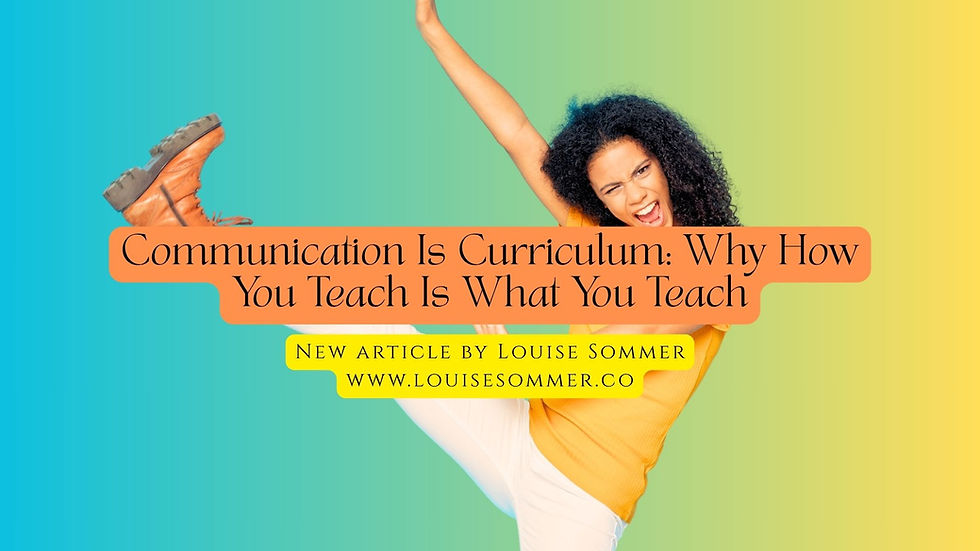Communication Is Curriculum: Why How You Teach Is What You Teach
- Louise Sommer

- Aug 6
- 4 min read
Updated: Nov 15
In Denmark, there’s a common phrase adults say to children: “Do what I say, not what I do.”
And while it might sound harmless, it reveals something deeper, something that, in the world of teaching and communication, is a red flag. Because the truth is: We teach through how we live. How we show up. How we speak. How we respond when we don’t know. Communication is not a side note to our expertise. It is the curriculum.

The Invisible Curriculum of Communication
Whether you’re in a classroom, a therapy session, a Zoom workshop, or a leadership training, you are always teaching. Not just with your words, but with your tone. Your silence. Your energy. Your way of listening. Your emotional presence. This is what I call the invisible curriculum; the part of teaching, and expertise, that people feel before they understand.
People don’t just absorb content. They 'absorb' you.
Neuropsychology backs this up. The brain doesn’t store information in isolation. It processes learning through emotion, context, rhythm, and relationship. Mirror neurons fire when we observe someone else’s emotions or actions. This means we’re constantly teaching, even when we think we’re just talking.
Teaching Through Presence
When I’ve taught across cultures, I’ve always had to adjust. Not the message, but the delivery. Same knowledge, different communication. Why? Because how we connect is often more important than what we say.
Your presence is your curriculum. And presence is more than being physically in the room, it’s about being emotionally available. Responsive. Flexible. Self-aware.
Communication can become a bridge or a barrier. It's up to the sender. When students experience a felt sense of connection, the brain becomes more open to learning. When clients feel genuinely seen and heard, trust builds naturally.
This isn’t about polished delivery or chasing perfection. It’s about how your presence makes people feel. Yes, authenticity really does matter! It’s connection, not performance, that unlocks real learning. And any auditorium, training session, or classroom should make space for that.
When educators aren’t respected, supported, or given the opportunity to grow as communicators, the magic leaves the room. And with it, the full potential of both students and teachers is lost.
If we want more inspired students, we need to invest in more empowered educators. That’s where the real transformation begins.
What It Really Means to Communicate Your Expertise
We’ve been conditioned to believe that communicating expertise means sounding polished, academic, or disconneted. But real communication is about making your knowledge accessible, memorable, and human.
You are your message. Every pause, every story, every smile, every pivot, yes, that’s also part of the teaching. Expertise doesn’t live in what you know. It lives in your ability to translate what you know into language, feeling, and experience that others can absorb and integrate into their own 'knowing' system.
This is why tone matters. Why timing matters. Why how you show up is as important as what you say.
Final Thoughts
We have to stop separating knowledge from communication. The way we deliver knowledge shapes how it’s remembered if, it’s remembered at all. When I’ve coached scholars and international researchers on how to communicate their expertise, their first response was often fear. When I asked why, they said:
“Because I don’t understand how I can be academic and authentic, and even creative, at the same time… when what I teach is so important.”
That’s when I start talking about the brain and the nervous system. And that’s when everything shifts. They pause. They breathe. They begin to smile. Their shoulders drop. And they start to see something they hadn’t before:
“I can’t believe how much potential we’re missing in our educational institutions.”
That’s when the real conversation begins. That’s when the educator inside them begins to come alive again. And most often, when they walked out of my workshop, they carried something new; an idea they actually wanted to try because it inspired them! They didn’t just learn something. They felt connected to something.
And that changed everything. So next time you prepare to “teach,” pause. Breathe. And remember:
The curriculum isn’t just in your slides or your sentences. The curriculum is you.
I would love to hear your reflections on this topic. Join the conversation on LinkedIn, where I share more insights and invite dialogue with educators, creatives, and leaders worldwide. Connect to LinkedIn here.
Was this article inspiring and helpful?
Share it on social media
Pin it!
Send it to a creative friend who needs to read this
Louise Sommer (MA, Educational Psychology) is the founder of Louise Sommer Studio. She specialises in creative intelligence, learning design, and leadership communication across cultures. Through her writing, consulting, and workshops, Louise helps educators and leaders build learning cultures that think, feel, and grow.
Louise Sommer Studio Blog is a free space for learning created for educators, leaders, and creatives exploring the intersection of psychology, culture, and creative intelligence.
Louise Sommer (cand.pæd.psyk.) er grundlægger af Louise Sommer Studio. Hun er specialiseret i kreativ intelligens, læringsdesign og ledelseskommunikation på tværs af kulturer. Gennem sit arbejde med undervisning, rådgivning og workshops hjælper Louise undervisere og ledere med at udvikle læringskulturer, der tænker, føler og vokser.
Louise Sommer Studio Blog er et frit rum for læring, skabt for undervisere, ledere og kreative, der udforsker samspillet mellem psykologi, kultur og kreativ intelligens.












